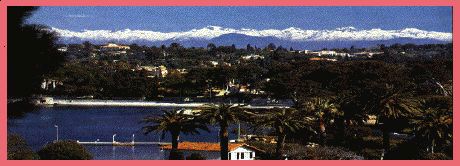



The Cap d'Antibes
Driving from the seafront at
Juan les Pins
the road winds its way towards the peninsular known as the Cap d'Antibes.
For several kilometres this road meanders in an out following the contours of the coast line and skirts a number of quite lovely coves such as Mouton harbour, the Piton moorings and the Olivette harbour.
Gradually the road narrows as it runs alongside the fortified watchtower of Grillon, built in the early eighteen-hundreds, which nowadays houses a small but very interesting museum of Napoleonic memorabilia.
A short distance from the museum is the famous Eden-Roc Hotel, often described as the most fabulous hotel in the world.
.
Everyone from the President of the Republic, to Arab princes, to stars of the stage and screen - all have stayed here in this security-conscious Shangri-La where credit cards are not recognised and hard cash is the only currency.
Close by - but not so close as to intrude on the Eden-Roc grounds is the Chines Verts Villa where Jules Verne stayed and wrote parts of his masterpieces.
A little further along, the road is bounded by high walls, beyond which cameras and other electronic devices oversee the entrances to magnificent villas standing in their own grounds, surrounded by luxuriant vegetation.
Here and there can be glimpsed miniature harbours complete with cranes to haul speedboats and other craft out of the water.
Beyond Illette Point there is a lighthouse which towers over the tiny cove the locals call the "Faux-Argent".
Summers visitors often argue as to whether the light emitted is silver, green or blue.
Nearby and tucked away out of sight, as it were, behind the Bacon Point is a small but sandy beach known as Jonquet Cove, which affords a magnificent view of the entire coastline.
On the other side of the road a path leads up to the church of Saint Benoit and further up the hill to La Garoupe, which has its own lighthouse and signal station.
This too affords a wonderful view of the coastline, this time almost from an eagle's perspective, which can the better be viewed by the aid of the telescopes installed for that purpose.
Here also is the ancient chapel of Notre Dame du Bon Port, founded in the fifth century by the monks of Lèrins.
It was built on the site of a pagan sanctuary dedicated to the moon goddess Selena.
An unusual aspect of this chapel is that it has two naves, one built in the 13th century and the other a hundred years later.
Visitors here are astonished to find that on one side of the altarpiece is a 14th century Russo-Byzantine icon and on the other side a superb piece of painted silk dating from the Middle Ages.
There is also a cross brought back from the Siege of Sebastopol and two gilded statues portraying "Our Lady who Guards" and "Our Lady of Safe Return".
This latter is honoured every July by the sailors of
Antibes
.
The rear and side walls of the chapel are covered with a collection of personal messages to the Virgin, some are of thanks, some are an entreaty.
One poignant message is: a baby's sock is pinned to the wall with a message imploring the Virgin to care for the soul of its former owner.
Somewhat further down the hill and toward the middle of the peninsular is the Chateau Thénard where the Grand-Duke Nikolai lived the latter part of his life.
However he may have lived in his native Russia, before he died in 1924 he surely never could have complained at being exiled to this veritable paradise.
A superb walk around the eastern half of the Cap d'Antibes provides a fitting end to this discovery of the Cap.
Visitors should take the small Tirepoil path at the end of the Garoupe beaches.
This round trip follows the shoreline as far as the Chemin des Douaniers and the Avenues Beaumont, Tour Gandolphe and André Sella, and then returns to the Garoupe beaches.

Created, composed, and constructed by Virtual Riviera 1995